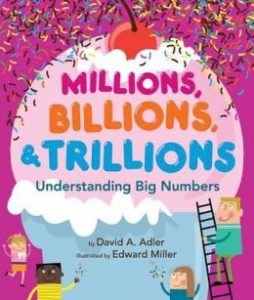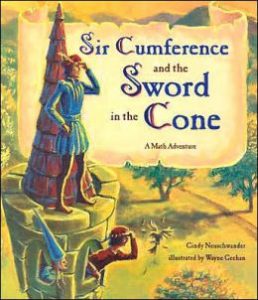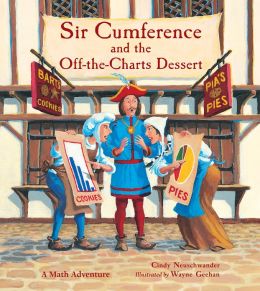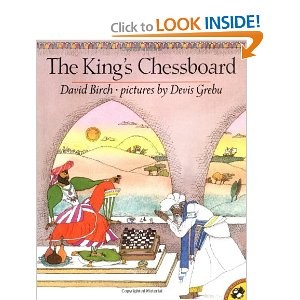When I was in elementary school it was called “arithmetic,” and one of the most terrifying aspects of that class was timed drills—the teacher would give everyone a single page of simple addition, subtraction, multiplication or division problems and we had to fill out as many answers as possible in five minutes. This always caused a brain freeze and subsequent panic in me, especially after time was called and we swapped papers for grading and I would score the lowest. (Since then I’ve comforted myself with the fact that many literary geniuses were hopeless with numbers.) Arithmetic was not considered a creative subject, but of course it is—its quantifiable character is perfectly compatible with a creative approach, as these books show. There’s no substitute for math drills (much as I hated them), but supplementary treatments like this might help ease the blinding abstractness of it all:
 Millions, Billions, and Trillions, by David Adler. Holiday House, 2013, 32 pages. Age/interest level: 6-8
Millions, Billions, and Trillions, by David Adler. Holiday House, 2013, 32 pages. Age/interest level: 6-8
“What does one million look like?” Fill a ¼ cup measure with granulated sugar and pour it out on a piece of black construction paper—that’s about one million tiny grains of sugar. Start counting! Or don’t—just take their word for it, because if you tried to count one grain per second without stopping it would take 11 ½ days. So . . . how about a billion? If you rounded up 10,000 people, each with an average head of hair, all of you together could total about one billion hairs. It would take 32 years to count them all at a rate of one per second. But what about a TRILLION? You can see where this is going: the kicker, for me is the page about the national debt: “When politicians talk about how much our government spends and how much it owes, it’s good to know how much a trillion is.” That’s an understatement; how many dollars would it take to send this book to every member of Congress and every department of the administration?
That’s a Possibility! a Book about What Might Happen, by Bruce Goldstone. Henry Holt,  2013, 32 pages. Age/interest level: 5-8
2013, 32 pages. Age/interest level: 5-8
Statistical language—probability, odds, outcomes, and even permutations—goes over the heads of most adults, not to mention children. What does it mean that there’s a “high probability” of something happening, or do those words even make sense together? This book is a great way to introduce not only basic statistical language but also statistical ways of thinking to elementary age kids, and chances are they’ll even enjoy it. Starting with possibility (“If something can happen, it’s a possibility”), impossibility, and certainty, kids are encouraged to think through the solutions of simple problems where the answer is either apparent in the picture or a matter of common knowledge. For example, one page shows a flock of pigeons, two white doves and one yellow dove on power lines: “If one of these birds flies away, what color will it probably be? What colors are possible, but not likely? What colors are impossible?” Activity suggestions at the end of the book reinforce the learning, and if you’re planning a trip to Vegas, the author includes probability analysis for dice and cards. Just saying.
 Sir Cumference and the Sword in the Cone, by Cindy Neuschwander, Illustrated by Wayne Geehan. Charlesbridge, 2003, 32 pages. Age/interest level: 6-12
Sir Cumference and the Sword in the Cone, by Cindy Neuschwander, Illustrated by Wayne Geehan. Charlesbridge, 2003, 32 pages. Age/interest level: 6-12
“One fine morning, Sir Cumference, Lady Di of Ameter, and their son, Radius, sat eating breakfast in King Arthur’s castle.” That opening sentence will give you a taste of the bad puns and leisurely narrative pace of this series of math-concept stories. Most of them are not about Sir Cumference, despite his prominence in the titles, but about Radius and his peers, specifically his friend Vertex and his cousin Per. That anomaly aside, these are pleasant little stories that set forth mathematical concepts (mostly geometry) in an entertaining way. In The Sword in the Cone, the heirless King Arthur has decreed that his successor will be the knight who finds his legendary sword, Edgecalibur, hidden somewhere about the castle. The clues are a series of odd diagrams and a cryptic rhyme, which Radius and Vertex solve by adding edges and points. There’s enough story to keep younger readers involved and the math challenges are just challenging enoug h to engage a reasonably astute fourth-grader.
h to engage a reasonably astute fourth-grader.
The newest title in the series, which I haven’t had a chance to look at, is Sir Cumference and the Off-the-Charts Dessert, a problem that involves pie charts and graphs. Others are The Isle of Imeter (formulas), The great Knight of Angleland (degrees and protractors), The Viking’s Map (geographic coordinates), The First Round Table (areas and perimeters), All the King’s Tens (decimal grouping), and The Dragon of Pi (pi, obviously). I can’t count for the effectiveness of all of them, but they’re worth checking out as entertaining supplements to particular math concepts.
Here’s an oldie-but-goodie from Megan:
For more math-concept picture books, see “Crazy Numbers.”
Stay Up to Date!
Get the information you need to make wise choices about books for your children and teens.
Our weekly newsletter includes our latest reviews, related links from around the web, a featured book list, book trivia, and more. We never sell your information. You may unsubscribe at any time.
Support our writers and help keep Redeemed Reader ad-free by joining the Redeemed Reader Fellowship.
Stay Up to Date!
Get the information you need to make wise choices about books for your children and teens.
Our weekly newsletter includes our latest reviews, related links from around the web, a featured book list, book trivia, and more. We never sell your information. You may unsubscribe at any time.
We'd love to hear from you!
Our comments are now limited to our members (both Silver and Golden Key). Members, you just need to log in with your normal log-in credentials!
Not a member yet? You can join the Silver Key ($2.99/month) for a free 2-week trial. Cancel at any time. Find out more about membership here.
8 Comments
Leave a Comment
You must be logged in to post a comment.


Most of my twelve children are required to complete upper level math courses, but we have one daughter, very artistic, for whom our goal is enough math sense not to mess up her poor future husband’s checkbook. She is twenty, and we are still working toward that goal. If you have any suggestions for her, we would love to hear them!!
We have a couple of the Sir Cumference books and the children really enjoy them, although sadly they are paperback and have not held up very well. We have used the King’s Chessboard many times over the years also. Looking forward to checking out your other two suggestions!!
Great post! Even though I’m a high school librarian, I love to order picture books for our teachers to use teaching challenging concepts. We have the Sir Cumference books but I am putting the others on my order list. Thanks for the heads up!
Thanks for the suggestions! Always looking for ways to teach my kids that math is cool!
Two other books that we have enjoyed are:
A Place for Zero by Angeline Sparagna LoPresti
Multiplying Menace: The Revenge of Rumplestiltskin by Pam Calvert
We love Sir Cumference books! I agree, books like these make learning fun!
Just now reading this! But there are some older ones that are similar to these if folks are having trouble finding the titles above…
How Much is a Million? by David Schwartz and illustrated by Stephen Kellogg is a great companion to Millions, Billions, Trillions
One Grain of Rice by Demi is the same Indian folktale as The King’s Chessboard but with a girl as the main character
And, of course, for those kids who just feel like math has invaded their lives, you can always check out Scieszka’s Math Curse 🙂
[…] interesting picture book just because! For more math-related picture books, check out the recent math picture book coverage on RedeemedReader. Robbins has created more beautiful photo-essays in picture book form I can’t wait to check […]
We like the Sir Cumference books too!
Other math books we have enjoyed are:
The Life of Fred series
You Can Count on Monsters (explains prime numbers with not-at-all scary number creatures)
What’s Your Angle, Pythagoras?
The Grapes of Math: Mind-Stretching Math Riddles
Thanks, Heidi! We’ll look up these titles. Another math riddle book is Edgar Allen Poe’s Pie, reviewed here.